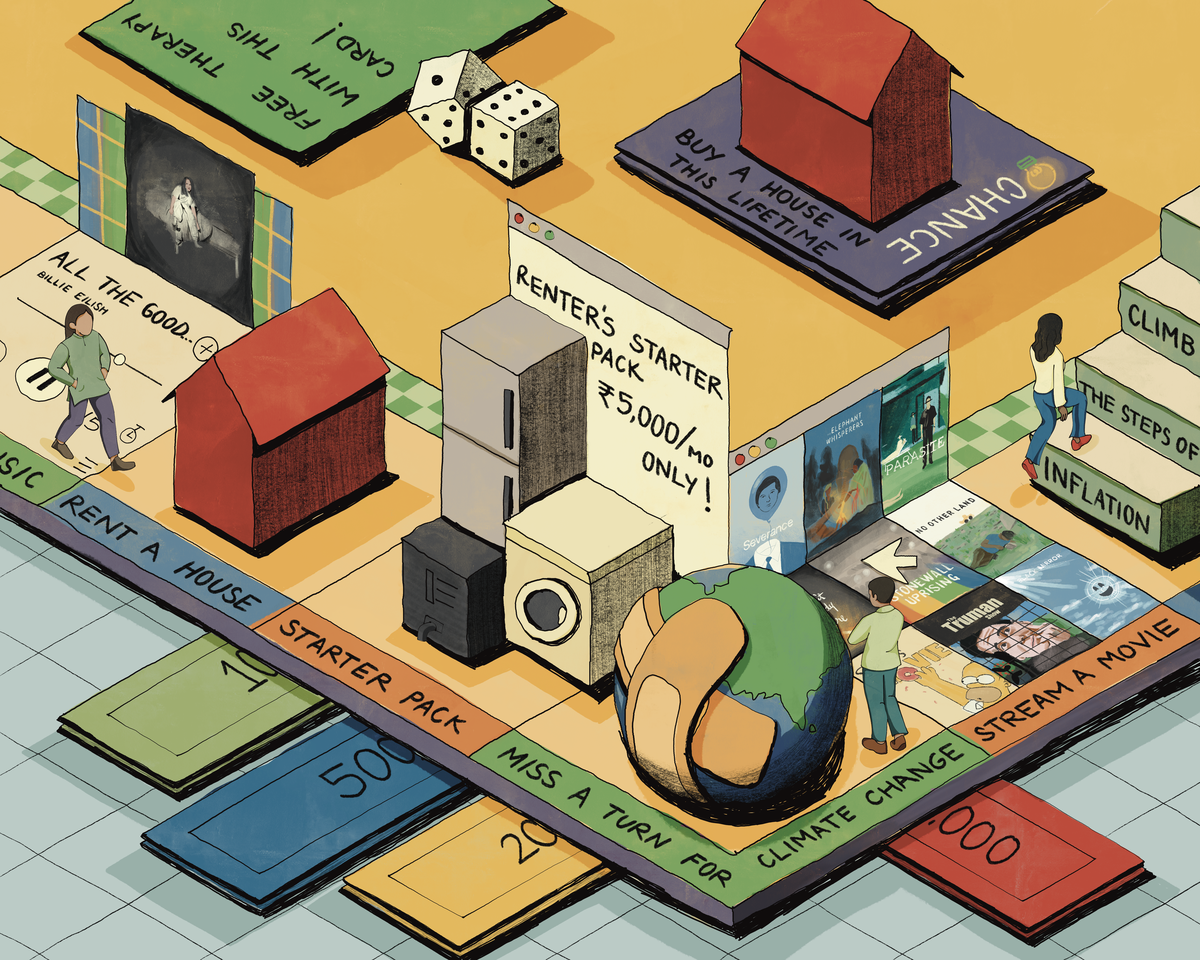On an otherwise unremarkable Friday in July 2009, amazon.com executed a digital disappearing act, silently removing two books from every Kindle e-reader across the United States. The rationale offered — improper addition by a publisher — did little to quell the irony that these very texts, Animal Farm and 1984 by George Orwell, which explored themes of censorship and control, had themselves vanished into a digital “memory hole”. The incident starkly brought to light a fundamental truth of the digital age: the act of “buying” today is often less about ownership and more about acquiring a license, revocable at the whim of the provider. Amazon’s subsequent pledge against future silent deletions offered some reassurance, yet the e-commerce giant retained the rights to do so anyway.
Filmmaker Kabir Mehta, 34, experienced a similar digital dispossession around 2012. Leveraging a U.S.-based iTunes account through a relative, he had painstakingly uploaded his CD collection, trusting the software to recognise and integrate the tracks into his digital library legally. The launch of iTunes in India a few months later abruptly severed this access, localised contracts rendering his meticulously curated playlists blank. “I didn’t bother holding on to the physical versions of many tracks once I had added them to iTunes. I was quite devastated to see my library empty,” recounts the Goa-based director and screenwriter.
Kabir Mehta
| Photo Credit:
Courtesy @kabirmehta
Mehta’s experience foreshadowed a broader trend. The traditional concept of ownership has become increasingly nuanced in the intervening years. Physical media such as DVDs have largely ceded ground to streaming platforms, personal music collections to subscription services, and tangible books to digital thumbnails. Simultaneously, external economic pressures and shifting lifestyles are reshaping our relationship with physical possessions. A 2024 TechSci Research report highlights a surge in renting, from homes and vehicles to electronics and furniture, driven by skyrocketing property prices, increasing mortgage rates, and a growing preference for flexible living arrangements.
“Cost of living has not matched up with salaries in the country, and a minimum living wage for all is still a far-fetched dream,” says Hyderabad-based economist Kumar Gautam. “A person with a dependent child finds it difficult to run their household even with a ₹1 lakh monthly paycheck — where does Gen Z even begin to plan for the future?” The economic strain is evident in the rising tide of consumer debt. According to TransUnion CIBIL, India’s outstanding credit card debt reached approximately ₹2.92 lakh crore as of last December, a significant jump from the previous year’s ₹2.53 lakh crore. In this unstable economic landscape, coupled with the relentless push of consumerism, the prospect of long-term investment feels increasingly distant for younger generations.

“It is only normal that we are more interested in consuming digitally — we have run out of mental and physical space to give tangible things the attention they deserve.”Shweta Kapur, 37Fashion designer and founder of Delhi-based ready-to-wear brand 431-88, who focuses on launching mindful capsule collections
Shweta Kapur
| Photo Credit:
Courtesy @shwetakapur
The death knell of ownership
For generations, ownership was a key marker of success and stability. But today, it is dying out. Technology, economic stagnation, and consumer options have created an era of access, instead. And the allure of the access economy, with its promise of instant gratification and boundless options, is undeniably strong. “I have never had an issue with renting or subscribing to things, I don’t really think about what I will own 50 years from now — imagining even two decades into the future feels like an existential crisis,” says Haroon Sharma, 22, a college student from Ahmedabad, adding that he wants to be able to opt out, try new services, move to another city (if that’s better for his career) without the burden of ownership. “But not having the option of owning at all is not something any of us asked for,” he states, highlighting the inherent tension between the convenience of access and the potential loss of agency — think reduced choices, potentially higher prices, and a lack of transparency.
Bengaluru-based Sushmita Bhalerao, a corporate strategy analyst at Goldman Sachs, observes a fundamental shift in generational values, too. “While once owning something was the largest marker of financial security, the digital native generation has got comfortable with not keeping things for good.” She also points to the economic incentives driving this shift. “Most corporations have realised how financially beneficial subscription models can be in a capitalist economy. Keeping consumers on the hamster wheel, getting them to buy carelessly and buy more is a sure-shot way to keep making profits.” This corporate philosophy has manifested in eyebrow-raising ways, from BMW’s attempt to charge a subscription for heated seats in 2023 — a proposal the German car manufacturer abandoned after customers complained about having to pay $18 a month to use in-built features — to HP’s “Instant Ink” service, where users have to pay a monthly page allowance on their own printers.
Technology, economic stagnation, and consumer options have created an era of access
| Photo Credit:
Illustration: Srishti Ramakrishnan
The software industry was one of the early adopters of the subscription-based model. While it eliminated the need for upfront purchases, it also came with its own set of ‘expensive’ problems. “As a graphic design student, it is terrible not to have the option to buy software like Photoshop, Illustrator or InDesign. It costs about ₹734 per month for a single software, and about ₹1,916 per month for the bundle,” laments Saniya Kakkar, 23, a Mumbai-based graphic designer. Even user-friendly options such as Canva, which began with affordable subscriptions, have now amped up rates. Its Teams feature, which cost ₹4,000 for three users now charges the same fee for a single user.
We are slowly heading towards a world where “everything can only be borrowed”, warns Gautam. “And these costs never trail off. You keep paying for things consistently if you want them, down to the albums that store your photos,” adds the economist. This perpetual state of borrowing contributes to significant anxiety, particularly among younger demographics. “Even though most older generations assume younger people have it easier, this is adding to major financial anxiety alongside living in a politically volatile world,” notes Delhi-based mental health therapist Ruchi Ruuh.
Moreover, the constant influx of new digital content only fosters a sense of fleeting engagement. “We constantly need the newest thing… [to] signal our ‘status’. With digital purchases, we barely keep count of what we are buying, and we don’t use things to their full potential as much as we used to. We don’t reread a book or listen to the same track because so much more is available at our fingertips. We own so recklessly that nothing holds value,” she adds.

“I am a magpie for beauty, and wherever I find it, I pick up little pieces of joy, whether it’s clothes, art, books, jewellery, tchotchkes — anything that will physically remind me of the moments I have lived.”Kaustav Dey, 42VP of marketing for Tommy Hilfiger and Calvin Klein, based in Bengaluru, for whom travel experiences transcend digital documentation
Kaustav Dey
| Photo Credit:
Courtesy @kaustav.dey
Nostalgia has its place
Delhi-based entrepreneur Kalyani Saha Chawla, 50, TV personality and founder of Rezon Luxury Silverware, has always understood the importance of permanence. “When I look at books from my grandparents, with the little handwritten messages on the opening pages, it speaks to me. With digital purchases, there is a lack of personalisation alongside a lack of control,” she observes. The ephemeral nature of digital ownership also breeds a sense of vulnerability. “We live with this fear that if there is a glitch in our cloud, we might lose all our photos, our memories of cherished moments.”
Shrimoyee Chakraborty, 35, advocates for a balanced approach, emphasising the importance of valuing the analogue world while embracing the benefits of the digital. “I do not have a television at home; I make sure to play the classics — from [Martin] Scorsese to [Satyajit] Ray — on a projector for my four-year-old daughter to grow up and appreciate our cultural inheritance,” says the Mumbai and London-based chef and flimmaker. “She can have an iPad and still value owning a film or art.”
Shrimoyee Chakraborty
| Photo Credit:
Courtesy @shrimoyeec
Meanwhile, Delhi-based fashion designer Mayyur Girotra, 44, is of the mind that in an increasingly digital world, the significance of tangible possessions is amplified. An idea cemented by the stone plate illustrations he sent for his New York Pride show invite recently. “Real luxury lies in permanence. Since we are obsessed with fast access, the things we can hold in our hands and hearts matter deeply,” he asserts.
Mayyur Girotra
| Photo Credit:
Special arrangement
However, for many among Gen Z, this appreciation for tangible permanence feels increasingly out of reach. Anish Gawande, 28, a national spokesperson for an Indian political party, points to alarming economic indicators. “Savings are at a 50-year low, and most young Indians are borrowing to meet consumption expenditures, not to buy a house or gold.”
Anish Gawande
| Photo Credit:
Special arrangement
He believes these are clear markers of an upcoming global recession. “People invest in smaller luxuries when they can’t even plan on investing in a big-ticket purchase.”

“Previous generations did not have someone else constantly controlling their data. Nobody could swoop into my house and take away my copy of Rushdie’s Satanic Verses when it was banned for a while, for instance.”Kabir MehtaFilmmaker, highlighting the tangible security that physical ownership can afford
Shifting goalposts of life
Access economy, as news platform Medium put it last year, is “changing our economic incentives, our social behaviors, our family dynamics, and the nature of our communities. Some — most notably those who profit from the shift — argue this transition is creating a new level of freedom, flexibility and sustainability. But the truth is, we’re losing the economic mobility and stability that ownership traditionally provided.”
While the confluence of several factors are shaping this generational shift, “we must remember that the environment, the world and mainly the goalposts of life have moved”, says Pooja Dhingra, 38. The patissier and founder of Le15 India has witnessed the shift in consumer behaviour first-hand through her business. “Home ownership, financial security, and even building savings have all become much tougher. This impacts how we consume. There’s a focus on access because stability feels out of reach. Flexibility is survival.”
Pooja Dhingra
| Photo Credit:
Special arrangement
Research from the University of Warmia and Mazury in Olsztyn, Poland, supports this observation, projecting that Gen Z will likely achieve milestones such as first homeownership and starting families significantly later than previous generations, with a greater reliance on parental support. As 19-year-old IT intern Somaya Khatri says, “I’d like to own things just like my parents — I’d love to leave a record collection for my children. But right now, a Spotify subscription for ₹119 per month seems too good to forgo.”
Ultimately, the tension between ownership and access reflects deeper power dynamics. It’s no coincidence that prevailing forces discourage ownership at its core. The consolidation of land, culture, and even our digital memories in the hands of a few raises a fundamental question: in a post-ownership world, who do we belong to?
The Mumbai-based writer, artist and editor reports on fashion and culture.
Published – May 09, 2025 04:54 pm IST





































![Top 10 Countries With Most Powerful Military Strength [2025] – Forbes India Top 10 Countries With Most Powerful Military Strength [2025] – Forbes India](https://i1.wp.com/images.forbesindia.com/media/images/2023/Nov/img_223273_top10countrieswithstrongestmilitarypower.jpg?w=400&resize=400,240&ssl=1)
![Top 10 Countries With Most Powerful Military Strength [2025] – Forbes India Top 10 Countries With Most Powerful Military Strength [2025] – Forbes India](https://i1.wp.com/images.forbesindia.com/media/images/2023/Nov/img_223273_top10countrieswithstrongestmilitarypower.jpg?w=80&resize=80,80&ssl=1)





